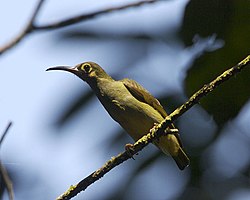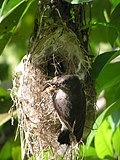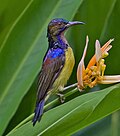Sunbird
Sunbirds and spiderhunters make up the family Nectariniidae. They are small, slender passerines from the Old World, usually with downward-curved bills. Many are brightly coloured, with iridescent feathers, especially the males. Many species have long tail feathers. They live mainly in equatorial regions. There are 145 species in 16 genera.
| Sunbirds and spiderhunters | |
|---|---|

| |
| ♂ Vigors's sunbird from Maharashtra, India | |
| Scientific classification | |
| Kingdom: | Animalia |
| Phylum: | Chordata |
| Order: | Passeriformes |
| Superfamily: | Passeroidea |
| Family: | Nectariniidae Vigors, 1825 |
Most sunbirds feed largely on nectar, but will also eat insects and spiders, especially when feeding their young. Long narrow flowers are punctured at the base near the nectaries, where the birds get the nectar.[1] Fruit is also often part of their diet.
The sunbirds have similarities with two distantly related groups: the hummingbirds of the Americas and the honeyeaters of Australia. The resemblances are due to convergent evolution. They all have a similar nectar-feeding lifestyle.[2] Some sunbird species can take nectar by hovering like a hummingbird, but they usually perch to feed.
Sunbird Media
Female Seychelles sunbird at the nest with prey
References
- ↑ Geerts, S.; Pauw, A. (2009). "Hyper-specialization for long-billed bird pollination in a guild of South African plants: the Malachite Sunbird pollination syndrome". South African Journal of Botany. 75 (4): 699–706. doi:10.1016/j.sajb.2009.08.001.
- ↑ Prinzinger, R.; Schafer T.; Schuchmann K.L. (March 1992). "Energy metabolism, respiratory quotient and breathing parameters in two convergent small bird species : the fork-tailed sunbird Aethopyga christinae (Nectariniidae) and the Chilean Hummingbird Sephanoides sephanoides (Trochilidae)". Journal of Thermal Biology. 17 (2): 71–79. doi:10.1016/0306-4565(92)90001-V.









